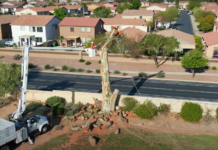Irving Harold “Mel” Skhal, a Navy veteran and Pearl Harbor survivor who lived in Hidden Valley, died Aug. 15.
Skhal was aboard the USS Downes in Pearl Harbor when the Japanese attacked the U.S. Navy. Below is an article by Joe Giumette about one of our nation’s heroes, published in the May/June 2007 edition of 85239 The Magazine:
Irving Harold Skhal’s eyes became narrowed and more intense, and his frail hands chopped the air in his Hidden Valley home as he haltingly struggled to describe an event that happened 66 years ago.
In a motorized wheelchair now, unable to walk or drive, his narrative peels away the years, the pain and fear, and even the eventual stigma he was to bear. Skhal is once again a seaman apprentice, returning to his ship, the USS Downes, in dry dock at the shipyard in Pearl Harbor.
He has just boarded his ship around seven in the morning on a peaceful Sunday in Hawaii, having enjoyed a big breakfast ashore. He hears airplanes on the horizon, and his sharp, 19-year-old eyes make out the rising sun on the planes gliding above.
Zeroes! Japanese aircraft!
Before he can react physically, the bombs begin to detonate, and machine-gun fire from strafing aircraft begins to pepper the area nearby. The call to general quarters is sounded and Skhal — on his first wartime mission at sea — runs to his post, manning one of the destroyer’s five-inch guns. The Downes, in dry dock with the USS Cassin and the battleship USS Pennsylvania, comes under heavy attack. An incendiary bomb lands between the two destroyers, starting raging fires fed by oil from a ruptured fuel tank.
Despite heavy strafing, the crews of the two destroyers get their batteries into action, driving off further attacks by Japanese planes. The dry dock is flooded in an effort to quench the fires, but the burning oil rises with the water level, and, when the ammunition and torpedo warheads on board the destroyers begin to explode, the two ships are abandoned. Cassin slips from her keel blocks and rests against Downes. Initially listed as complete losses, both destroyers live to fight again.
Meanwhile, Skhal leaped across a gangplank engulfed in flames, and a superior officer threw him an old 3030 rifle. Ashore, he stood ground for a few minutes, angrily but hopelessly aiming and firing at the Japanese attackers as they swooped down on the carnage, with explosions and fires raging around him and the rest of his 150 crewmates.
Skhal survived World War II’s first attack on the U.S. and went on to fight aboard the USS Maury in 14 of the nation’s most vital sea battles, including Midway, Wake Island and Guadalcanal.
But Skhal’s longest and most difficult fight didn’t involve the enemy, ships or weapons; it was his 35-year-long battle to obtain the honorable discharge he felt the Navy owed him.
Born in Devils Lake, N.D. in 1922, Skhal left everything he knew to join the Navy before he was 18. At Great Lakes Naval Training Center near Chicago in 1940, he was assigned to join the USS Downes in San Francisco. The Downes, commissioned in 1937, was dispatched to Honolulu for Skhal’s first voyage and for a routine cleaning in dry dock.
After surviving the Japanese attack, Skhal volunteered for service aboard another destroyer, the USS Maury, which escorted the USS Enterprise, one of the fleet’s proudest carriers, to its many adventures in the South Seas.
During a shore leave later in the war, Skhal returned to base a little late from Washington state, where he had visited his mother. An exacting officer ordered him to serve five days in the brig, with a diet of only bread and water. Skhal, frustrated by what he viewed as harsh treatment, broke out and was re-captured soon after, only to be incarcerated again. This struggle of wills continued until Skhal finally was discharged from the Navy before the war ended. His discharge was rated “bad conduct.”
An angry but unbowed Skhal quickly joined the Merchant Marine and served another 10 years as a commercial seaman before meeting and marrying Shirley Burr, the mother of four. Together the couple fought the naval bureaucracy, struggling but determined to see that the Pearl Harbor veteran at least received what he felt the Navy owed him: an honorable discharge. That finally happened in 1980, and Skhal and his wife, now living in Alaska, retired to Hidden Valley in 1998, primarily for health reasons.
Skhal, who had begun using the name of his brother, Mel, in an attempt to avoid the stigma he felt was associated with the bad conduct discharge, once again assumed his proper given name. Mel had died in the war.
What enemy weapons failed to accomplish in all of those battles, Mother Nature has. Skhal’s health is failing. At 84, he has suffered at least six strokes. His left leg is useless, and his right arm is partially paralyzed. He doesn’t attend as many meetings of the Veterans of Foreign Wars, the Disabled American Veterans or even the Pearl Harbor Survivors Association as he once did, but his spirit has not been dampened.
“Take a look at this,” he proudly commented, as he showed a visitor a motorized wheelchair ramp at one side of his new van. “That’s how I get aboard now.”
Photo by Aaron Thacker


















